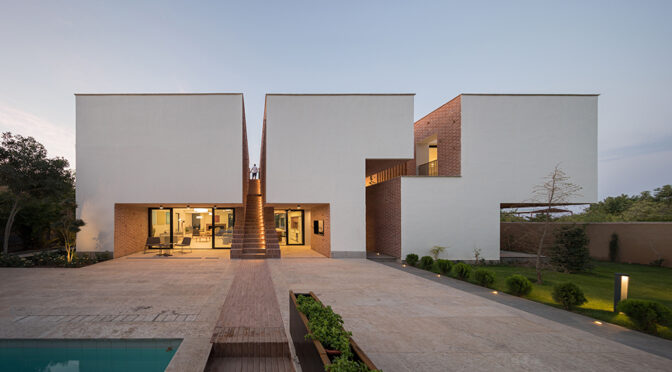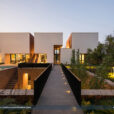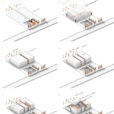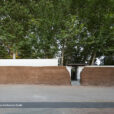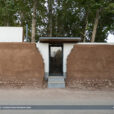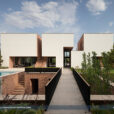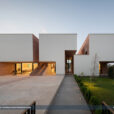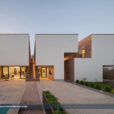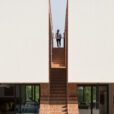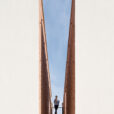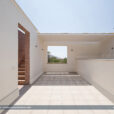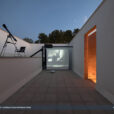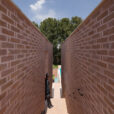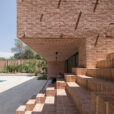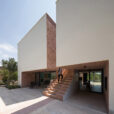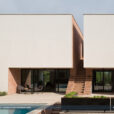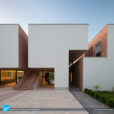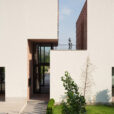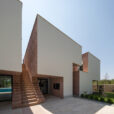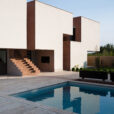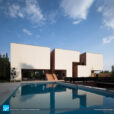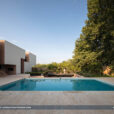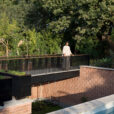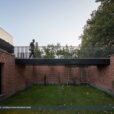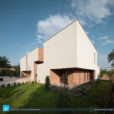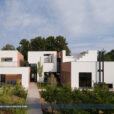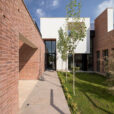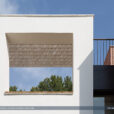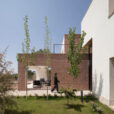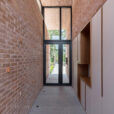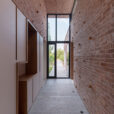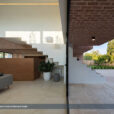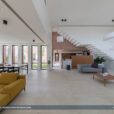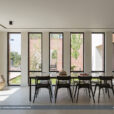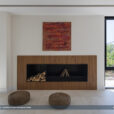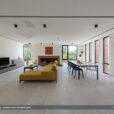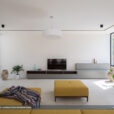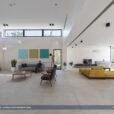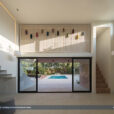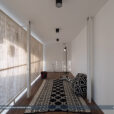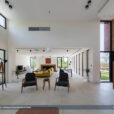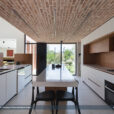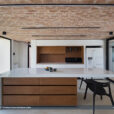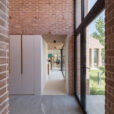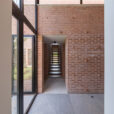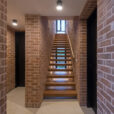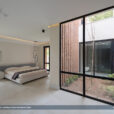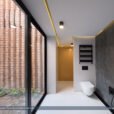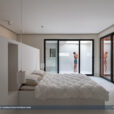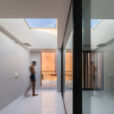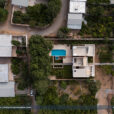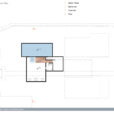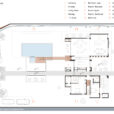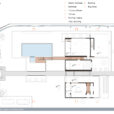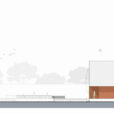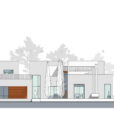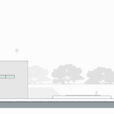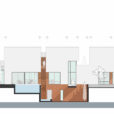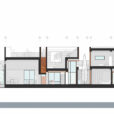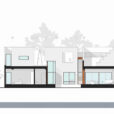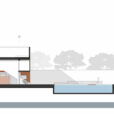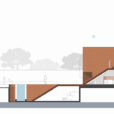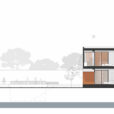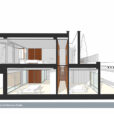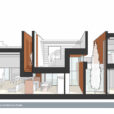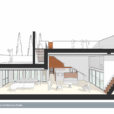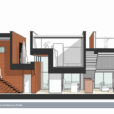ویلای ناربن
استودیو معماری گرا (حسین نمازی)
موقعیت: چترود، کرمان، ایران
تاریخ: ۱۴۰۱
مساحت: ۳۵۰ مترمربع
وضعیت: ساختهشده
کارفرما: مصطفی منظوری، رویا جمشیدی
تیم طراحی: مرضیه مهرانفر، مهدی عرب عامری، امیرمسعود دریکوند، مهراد قادری، محمد شکوری
سازه: آقای معینالدینی
تاسیسات: کاوه آهنگر داوودی
اجرا: استودیو معماری گرا
مدیریت اجرا: مهرداد عاقلنژاد
مدلسازی سهبعدی و گرافیک: امیرمسعود دریکوند
عکس: محمدحسن اتفاق
در ابتدا، با نگاهداشتن دیوار کاهگلی باغ و ایجاد دیواری در پشت آن، ضمن حفظ بافت موجود منطقه، به تعریف مجدد مرزهای پروژه با کوچه و رهگذران، و تداعی خاطرات قدیمی پرداختیم. سپس با ایجاد شکافی در دیوار و جانمایی یک درب شیشهای، ورودی باغ را تعریف کردیم تا بخشی از دارایی این باغ را که شامل درختان قدیمی چنار و نیز جوی آبی بود که از این ملک به زمینهای کشاورزی راه پیدا میکرد، با رهگذران و همسایگان به اشتراک بگذاریم.

پس از ورود به باغ، با ایجاد یک گودالباغچه، سایت را به ویلا مرتبط ساختیم، ساختمانی که فهم روشنی از آن وجود ندارد و با دو شکاف عمیق که بخشی از آسمان را به تملک خود درآوردهاند، معرفی میشود. در واقع، ساختمان ویلا یک هسته متراکم آجری چاکخورده است که فضاهای آن در میان این شکافها ایجاد و تکثیر شدهاند، بنایی که میخواهد روایتی از احساسها و تجربههای متفاوت را از درون خود بازگو کند، و با بهرهمندی از بازی نور و سایه، در هر لحظه از روز، بهگونهای متفاوت، خود را معرفی و ما را به سمت خود دعوت میکند.
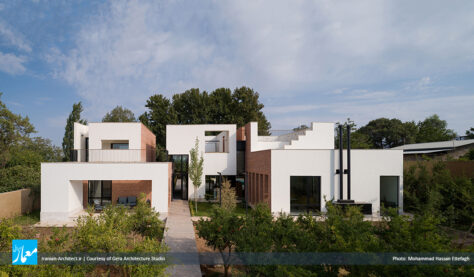
شکاف اول ساختمان، محور ورودی اصلی است که از طریق آن میتوانیم وارد خانه شویم یا راهمان را به سمت باغ و محوطه پشت ادامه دهیم. شکاف دوم نیز بهگونهای وسوسهانگیز ما را به بامها میکشاند تا در آنجا با استفاده از دیوارهای بلند سایهانداز و چندسطحیکردن بام، هم بتوانیم از تاثیرات سایهاندازی دیوارها برای هماهنگی با اقلیم بهرهمند شویم، و هم با ایجاد قابهایی از مناظر پیرامون، پیوند زندهای بین مخاطب و بنا شکل دهیم و فضایی را برای رصد ستارگان، تماشای فیلم و شبنشینی فراهم سازیم، و در واقع، بازتعریفی از عملکرد مغفولمانده بام که ریشه در این اقلیم دارد، داشته باشیم.
Narbon Villa
Gera Architecture Studio (Hossein Namazi)
Location: Chatrud, Kerman, Iran
Date: 2022
Area: 350 sqm
Status: Completed
Client: Mostafa Manzouri, Roya Jamshidi
Design Team: Marzieh Mehranfar, Mehdi Arab Ameri, AmirMasoud Derikvand, Mehrad Ghaderi, Mohammad Shakouri
Structure: Mr. Moeineddini
MEP Engineering: Kaveh Ahangar Davoudi
Construction: Gera Architecture Studio
Construction Management: Mehrdad Aghelnejad
3D Modeling & Graphic: AmirMasoud Derikvand
Photo: Mohammad Hassan Ettefagh
Initially, we preserved the thatched wall of the garden, while creating a new wall behind it. This allowed us to maintain the existing fabric of the context and redefine its boundaries with alleys, giving a nostalgic touch to passersby and evoking old memories. By creating a gap in the wall and installing a glass door, we established an entrance to the garden. This served the purpose of sharing the garden’s assets, such as the old sycamore trees and the watercourse is reaching the agricultural land from this property, with neighbors and passersby.
Upon entering, our aim was to connect the site with the house. We achieved this through a sunken courtyard, which provides a cool shade, during hot and long days. In this setting, we encounter a building that captures a portion of the sky, thanks to two deep rifts we refer to as “sky rifts” which are on the way of air circulation and wind that can help interior air conditioning. By utilizing sunlight, shadows, and architectural elements, the building presents itself differently throughout the day. In essence, the house’s spaces are distributed and interwoven between these rifts, a cracked dense core of bricks that aims to narrate a story of diverse emotions and experiences from within.
The first rift of the building is the axis of the main entrance; Once inside, we have the option to remain in the house or continue towards the back garden. Conceptually, the house functions as a pavilion, inspired by the architectural heritage of this climate and culture. The second rift also entices us to explore the roofs, where we can enjoy the shade provided by long walls and multi-level roofs. These walls and gaps not only help keep the building cool by creating shadows and saving the energy in hot days, but also frame the surrounding scenery, establishing a dynamic connection between the viewers and the building. Additionally, they create a space for stargazing, watching movies, enjoying nights out, and ultimately redefining the function of the neglected roof, which is deeply rooted in this climate and culture.

